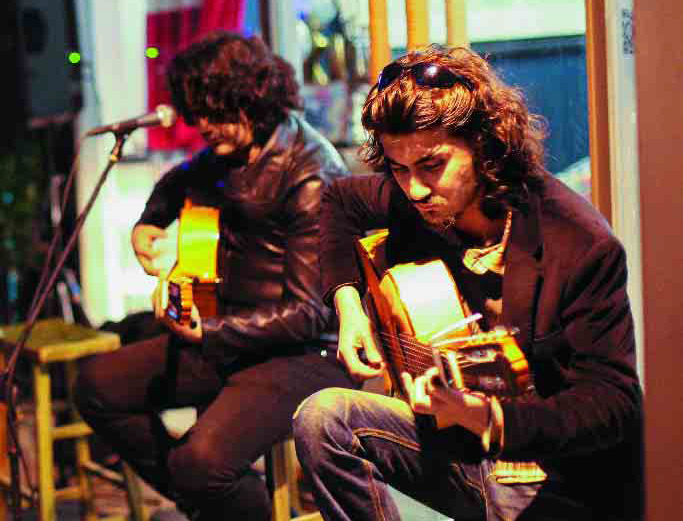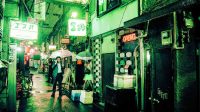Rarely has a city laboured under a reputation as undeserved as Shenzhen. When I mentioned to friends I was heading across the border, I received advice as varied as “bring a money belt, it is full of thieves” to “avoid the train station” – no easy task if you are travelling by train. Yet while many still perceive it as a place for cheap suits and massages, Shenzhen is home to art, music, nightlife and food that would leave your most plugged-in Hong Kong resident green with envy.
Best of all, Shenzhen is convenient. In less than an hour, you could be in a world- class art gallery, enjoying authentic cuisines from some of China’s most delicious provinces, or throwing your hands in the air to some of the most authentic hip hop in southern China – all for a fraction of the price of a numbing night out in Lan Kwai Fong.
Can’t stop the music
In Shenzhen, it seems every bar and coffee shop large enough for a guitar boasts live music at least one night a week. In one weekend, without even really trying, I saw acoustic jazz, live local hip hop, a punk show, an outdoor electric rock band busking in front of the symphony hall and a Western cover band, not to mention the DJs spinning in clubs all over the city and the ubiquitous Filipino cover bands.
Jazz bands, and flamenco bands made up of Uygur musicians from Xinjiang are something of a Shenzhen speciality, and the band at Penny Black Jazz Bar in OCT (Overseas Chinese Town) is one of the best. Just across the street is B10 Live, widely considered Shenzhen’s best live music venue, that boasts the most impressive sound system in the city. I went on a Friday night, and the queue was considerable.
Unfortunately, somebody in the crowd was stealing smartphones, which led to a police presence, and the shutting down of the show. If punk music is what you’re craving, head to Brown Sugar Jar, Shenzhen’s only dedicated punk rock club. Come ready to mosh and thrash; Shenzhen’s punks are serious and don’t hold back.
American musician Rue Moyer has launched Shenzhen Local Music (shenzhenlocalmusic.com), an online platform to help fans and musicians make sense of the rapidly ballooning scene. When I met up with him he was playing with a new band in OCT Bay, a new luxury development of bars and restaurants around a man-made lake. “Shenzhen has so many talented people and there are no rules,” Moyer says. “In Hong Kong you have all of these expectations. Here people are still exploring.”
He knows what he is talking about: in the past two years he has started four festivals and three open mic nights. His most recent festival, a hip hop one, drew over 1,000 people.
Going underground
Shenzhen nights are freewheeling to an extent wholly unknown in Hong Kong. Bars and clubs, mostly unregulated, stay open into the early hours of the morning and there are venues to suit any taste or persuasion. The dedicated nightlife areas of Coco Park (Shenzhen’s answer to Lan Kwai Fong) and Shekou Bay (where you can get drunk on a decommissioned cruise ship) are relatively well known. I decided to go off the beaten track to see what the city could offer to someone willing to get a little wild.
I centred my night around Shangbu Nan Lu, an up-and- coming bar street often ignored by tourists. I started at Hawa Cafe and Bar, a small vaguely tiki-themed bar in which a German DJ spun loud industrial techno interspersed with poppy dance songs.
Just down the street is Public, a small and smoky concrete box of a space full of Chinese hip hop heads throwing their hands in the air to a series of local rappers, riffing in Chinese while a DJ spun a mix of hip hop standards and original beats. The crowd was crazed but friendly and kept the cheap drinks flowing. By the time I managed to extricate myself, the whole bar was standing and chanting in Putonghua: “The real hip hop is in Shenzhen.”
Just down the street is lesbian hangout Xuan Cafe and Bar. Though the name changes often, the space has long been home to one of the city’s most debauched watering holes. Xuan is well known for its out-of-control dance parties that go into the early morning. When I visited, however, the poles on the tables were devoid of dancers, and at the bar the staff were busy cooing over a toy poodle. Next time I’ll save this place for last; at Xuan it seems the party doesn’t get going until late.
No night out in Shenzhen is complete without a visit to Guo Ma Lu where local club culture is alive and well. I quickly scuttled out of the first club, Candy Sweets+Beats Club, after a fight broke out at the coat check counter. Next door at Soho Bar I found something more my speed: a huge room packed with Shenzhen’s beautiful people dancing on tables and chairs to a local DJ under an over-the-top laser lightshow. In a matter of moments I was taken in by a group of local party animals who wasted a good bit of their night, and whisky, trying to teach me a Chinese drinking game.
It was after 2am, and I was wanting nothing more than the comfort of my hotel bed, when my phone buzzed informing me that the rumours of an underground tunnel rave happening that night had been confirmed. Tunnel raves are a Shenzhen nightlife staple and have earned a reputation all over the world. The second Saturday of every month a group of resourceful ravers take over one of Shenzhen’s many pedestrian tunnels turning it into a full- blown all-night dance party.
Unfortunately, by the time I found the tunnel, under a twisting knot of a freeway overpass, the police had already shut it down. After I helped someone I recall as a Bulgarian with vaguely demonic facial hair (though he may have been a clean shaven Swede for all I know) carry a generator out of the bushes, the crowd decided they would head to the local Ikea (why not?) to hit up another underground rave there. I had had enough. The crowd of hyped up party people left me on the side of the highway where I tried to hail a cab in the hope it would get me back to my bed before the sun rose. It did not.
A taste for adventure
Thanks to its status as a Special Economic Zone, the immigrant city has become a beacon for people from all over China looking to strike it rich. As a result, its food is a vibrant mix of culinary traditions and offers some of the best examples of regional cooking outside the provinces themselves.
Nathan Davis, a three-year Shenzhen resident, chef, and menu consultant couldn’t wait to show off the city’s bounty. Though he gushed about the food at Baia for its Mediterranean menu and the high-end Four Seasons Oyster Bar, we stuck to more local fare. One exception was Frankie’s American Bar, an authentic spot with a raucous vibe and some of Asia’s best American casual eats (the buffalo chicken burger alone is worth the trip over the border).
Shenzhen excels in its street food, and intensely flavoured regional delicacies. A great first stop is the Bai Shi Zhou neighbourhood where Davis makes his home: “It’s all right here and the street food is great.”
Bai Shi Zhou is one of the last vestiges of old Shenzhen with street-side eateries and carts competing with dogs, and motorcyclists for pavement space. The food is cheap and excellent, made by purveyors who have made one dish all day every day for years. Another area not to be missed is Xi Jie, an indoor foodie wonderland with stalls from all over the country. Xi Jie has a reputation for being touristy, but I was the only foreign face in the seemingly endless press of people. I was served a northern Chinese pancake with pork, fried egg, and pickled vegetables, an oversized cumin lamb skewer by a shirtless dancing Uygur with a mohawk, and ate a delicious local black sesame sweet soup.
Food trends such as veganism, and gluten-free options are taking hold in Shenzhen. Bao An Lu is widely known as vegetarian street and the Summer Tea House offers some of the best traditional Chinese vegetarian dishes I’ve ever tasted. The dumplings are especially delicious.
For art’s sake
Mention art to most people in Shenzhen and they immediately think of the Dafen Art Village, where painters specialise in copying anything from Van Gogh to Christmas cards. While the art scene here is relatively new, it is pervaded by a sense of excitement and optimism and inherent risk taking.
The centre of art in Shenzhen is the sprawling OCT Contemporary Art Terminal (OCAT). In the heart of the OCT neighbourhood, the terminal is a collection of gallery spaces, studios and outdoor sculptural installations. It is also home to an extensive library with hard-to-find resources about contemporary art in Asia.
“We have quite an extensive programme all year round,” says Bruce Bo Ding, from the public education department of OCAT. “They cover every facet of contemporary art and fine art; we will have programmes in theatre and performance and a comprehensive publications programme.” Artists and institutions here seem more willing to take risks than they would in, say, Beijing: when I visited there was an excellent exhibition of Chinese propaganda artists exploring how they were influenced by Western art.
Not all of the good art is found inside the OCAT though. Zai Gallery at Shekou Bay, which specialises in contemporary Chinese art, has a minimalist decor intersected by white brick walls that wouldn’t seem out of place in New York or Paris.



